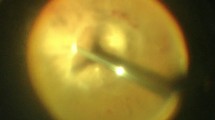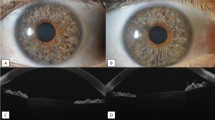Zusammenfassung
Die Kryokoagulation von Netzhautforamina kann zur Ausstreuung von retinalem Pigmentepithel führen, was die proliferative Vitreoretinopathie (PVR) stimulieren kann. In einer konsekutiven Reihe von 15 Augen von insgesamt 15 Patienten mit Netzhautablösungen < als 3 Quadranten ohne PVR wurde eine transsklerale Diodenlaserkoagulation (TD) durchgeführt. In keinem Fall wurde eine Exodrainage angeschlossen, eine Silikonplombe diente als Tamponade des Foramens (in 3 Augen 2 Foramen), eine primäre Netzhautanlegung wurde in allen Fällen erreicht, eine proliferative Vitreoretinopathie wurde in keinem Fall beobachtet, als einzige Komplikation trat eine Verbrennung am Muskelrand des Musculus rectus temporalis auf. Durch eine Laserbehandlung entsteht eine sofortige Verbindung zwischen retinalem Pigmentepithel und Netzhaut, eine Ausschwemmung von Zellen wird verhindert, womit theoretisch das PVR-Risiko vermindert wird. Obwohl der Zeitaufwand für eine transsklerale Diodenlaserkoagulation größer als für eine Kryobehandlung ist, lassen unsere vorläufigen Ergebnisse diesen Aufwand als gerechtfertigt erscheinen.
Summary
15 patients (15 eyes) were treated with transscleral diode lasercoagulation for uncomplicated retinal detachment without signs of proliferative Vitreoretionpathy (PVR). Exodrainage was not necessary in any case. A silicone buckle was used to tamponade the retinal break. Permanent sealing of the break was achieved in all eyes. Follow up was overall one year. No serious adverse effect, exept one small burn in a muscle (M.r.inf.) was observed. Lasercoagulation can avoid dispersion of retinal pigment epithelial cells (one possible reason for PVR), which occurs normally in cryocoagulation of retinal breaks. Beside the fact that TD is more timeconsuming than cryocoagulation, it may eventually avoid PVR.
Similar content being viewed by others
Literatur
Bames SD1,2, LoRusso FJ1,2 (1995) Does transscleral diode laser retinopexy enhance dispersion of viable retinal pigment epithelial cells? 1Wilford Hall Medical Center, Lackland Air Force Base, TX;2Brooke Army Medical Center, Fort Sam Houston, TX ARVO Abstract Invest Ophthalmol Vis Sci 39 [4, Suppl]: 506
Benner JD, Galustian JC, LIM M, Hjelmeland L, Landers MB, Morse LS (1995) Comparison of Techniques for transscleral diode photocoagulation in the rabbit. Retina 15: 253–260
Bonnet M, Fleury J, Guenoun S, Yaniali A, Dumas C, Hajjar C (1996) Cryopexy in primary rhegmatogenous retinal detachment: a risk factor for postoperative proliferative vitreoretinopathy? Graefe’s Arch Clin Expo Ophthalmol 234: 739–743
Colin A, García-Arumi J, Mateo C, Corcósteguli B (1993) Effect of transscleral diode laser photocoagulation applied through buckling elements. Evaluation in a rabbit model. Hospital Valle de Kebrón, Barcelona, Spain, ARVO Abstract. Invest Ophthalmol Vis Sci 34 [4, Suppl]: 1260
Cordeiro M, Pollack W, Woon H, Marshall J, Chignell A (1994) Tensile strength comparison of chorioretinal adhesions produced by diode, Argon laser, and Cryopexy. St. Thomas Hospital, London, Abstract. The Royal College of Ophthalmologists. Annual Congress. Guernsey. April 19–22
Jennings T, Fuller T, Vukich J, Lam T, Joondeph B, Ticho B, Blair N, Edward D (1990) Transscleral contact retinal photocoagulation with an 810 nm semiconductor diode laser. Ophthalmic Surg 21: 492–496
Kim JH1, Oum BS2, Lee SH3 (1996) Histopathologic and immunohistochemical findings of transscleral diode retinopexy: comparative studies with Cryoretinopexy.1Department of Opthalmology, Pusan Veterans Hospital;2Department of Ophthalmology Pusan National Univ. Hospital;3Lee’s Eye Clinic, Pusan, Korea. ARVO Abstract. Invest Ophthalmol Vis Sci 37 [3, Suppl]: 1874
Kletzky D, Cupples H, Gaasterland D (1992) Transscleral retinal photocoagulation with the diode laser. Worthen Center for Eye Care Research, Centfer for Sight, Georgetown Univ., Washington, D.C., ARVO Abstract. Invest Ophthalmol Vis Sci 33 [4, Suppl]: 3093
McHugh D, Schwartz S, Dowler J, Ulbig M, Blach R, Hamilton P (1995) Diode laser contact transscleral retinal photocoagulation: a clinical study. Br J Ophthalmol 79: 1083–1087
Packo K1 Torczynski E1 Jennings T2 (1992) The effect of transscleral 810 nm laser retinal photocoagulation on the ciliary nerves.1Rushz-Prebysterian-St. Luke’s Medical Center, Chicago, IL,2Univ. of IL, Chicago, IL. ARVO Abstract. Invest Ophthalmol Vis Sci 33 [4, Suppl]: 3092
Rosen R, Muldoon T, Walsh J, McCormick S (1992) A Cryolike, Semiconductor diode laser probe for transscleral retinopexy. Evaluation in a Rabbit Model. The New York Eye and Eyr Infirmary ARVO Abstract. Invest Ophthalmol Vis Sci 33 [4,Suppl]: 3090
Rosen R, Walsh J, Muldoon J, Rosenthal J, Clewner L, Gentile R (1995) Transscleral diode laser retinopexy for treatment of peripheral retinal tears. A pilot study. ARVO Abstract. Invest Ophthalmol Vis Sci 36 [4, Suppl]: 3899
Singh AK, Glaser BM, Lemor M, Michels RG (1986) Gravity dependent distribution rpe cells dispersed into the vitreous cavity. Retina 6: 77–80
Singh AK, Michels RG, Glaser BM (1986) Scierai Indetation following cryoyherapy and repeat cryotherapy enhance release of viable rpe cells. Retina 6: 176–178
Author information
Authors and Affiliations
Corresponding author
Rights and permissions
About this article
Cite this article
Kieselbach, G., Kralinger, M., Kremser, B. et al. Transskierale Diodenlaserkoagulation bei konventioneller Ablatiochirurgie. Spektrum Augeheilkd 14, 11–13 (2000). https://doi.org/10.1007/BF03162855
Issue Date:
DOI: https://doi.org/10.1007/BF03162855




